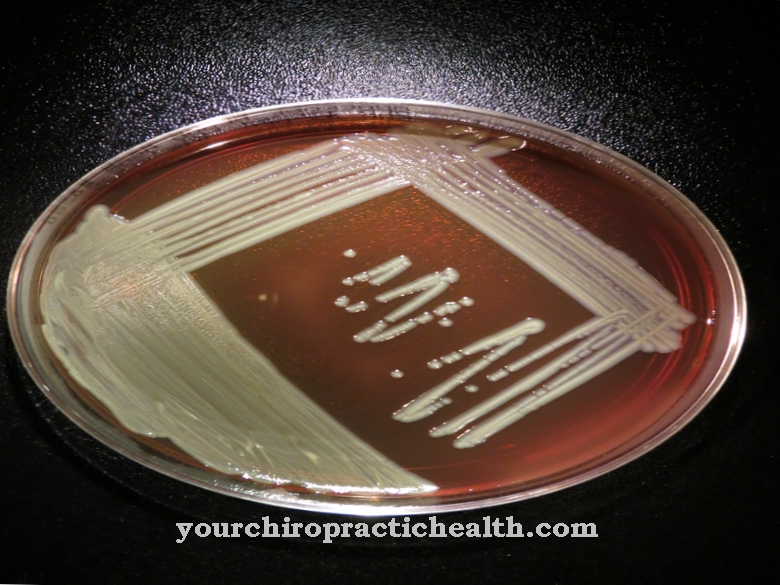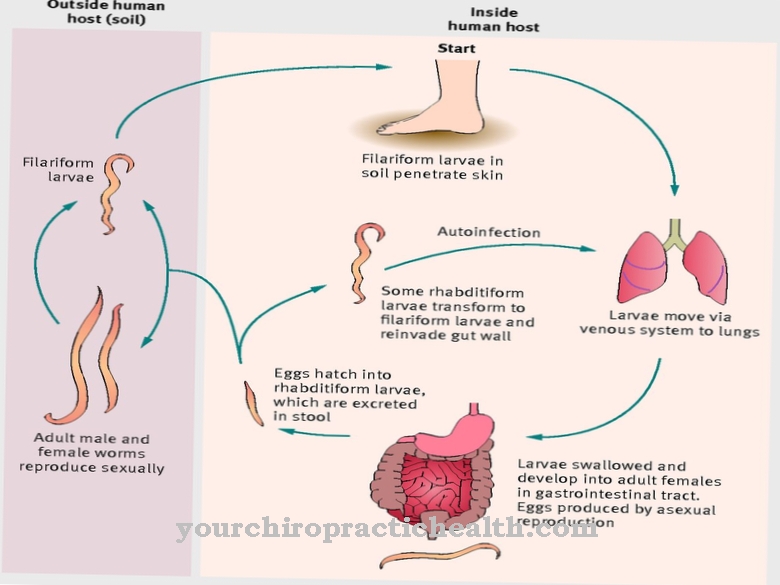T phage are viruses which, as bacteriophages, have specialized in the exclusive infestation of Escherichia coli intestinal bacteria (Coliphages). 7 different types are known, with the designations T1 to T7, of which the even-numbered types differ from the odd-numbered types by certain common features. T phages are usually recognized by the immune system in the body; outside of the body they are used specifically for the production of certain enzymes and for other purposes.
What are T phages?
T-phages are viruses that have specialized in attacking bacteria and are therefore called macrophages or simply phages. Each type of phage specializes in infecting a specific bacterium. The tailed T phages (the T is derived from the English 'tail') are designed to attack the intestinal bacteria Escherichia coli.
The 7 known T phages with the designations T1 to T7 belong to the three families siphoviruses (T1, T5), podoviruses (T3, T7) and myoviruses (T2, T4, T6). The even-numbered and the odd-numbered T phages each differ in several common features.
T phages are characterized by a complex structure. The main components are the base plate, injector and head. There are so-called spikes on the base plate with which the phage can cling to the bacterial wall and pierce it. The injection device consists of a contractile tube through which the DNA of the phage is "shot" into the coli bacterium. The double-stranded DNA is located in the head of the T-phage and, after docking with the bacterium, is transported through the contractile tube of the injection apparatus into the interior of the coli bacterium. After infection has taken place, the parts of the T phages remaining on the outside of the envelope are no longer required and detach themselves from the bacterial wall.
Occurrence, Distribution & Properties
T-phages, like other phages, can usually be found where bacteria are located. In wastewater and standing water, in which an enormously large and differentiated association of bacteria normally takes place, bacteriophages also occur in a similarly accumulated and differentiated form. Similar conditions can be found even in the extremely clean oceans.
In the human body, T phages can mainly be found in those places that are colonized by Coli bacteria. In healthy people with an intact immune system, this is primarily the digestive tract. T-phages that get lost in the bloodstream are recognized by the immune system and trigger an immune reaction that leads to the destruction of the phages. There is hardly any direct risk of infection with T phages, as they are not independent germs. With a correspondingly weak immune defense, it is only conceivable that T-phages cause a sensitive thinning of the coli bacteria within the intestinal flora.
T phages that are used for therapeutic purposes can be freeze-dried without losing their physiological properties.
Meaning & function
T phages, which can only infect and kill coli bacteria, only play a subordinate role in the human body. Targeted use against pathogenic coli bacteria outside the digestive tract would be conceivable. In contrast to antibiotics, which have a broad-spectrum effect, i.e. also destroy a large number of useful microbes, T-phages, like other phages, have an absolutely specific and selective effect against certain strains of germs.
However, phage therapy is subject to strict requirements in Germany, although in many cases it could be an excellent alternative to antibiotics. The problem of resistance development is also present with T phages, but it can be remedied just as quickly by cultivating modified macrophages. Phage therapy has developed particularly in countries of the former USSR, most of them in Georgia. Some western research groups are trying to grow phages that are also effective against multi-resistant germs.
T-phages are often cultivated in coliform bacteria for the production of enzymes in order to obtain larger amounts of enzymes that are required for molecular biological purposes. These are enzymes such as T4 DNA ligase, T7 RNA polymerase and a few others.
The ability of so-called temperate T-phages to incorporate their own DNA into the bacterial DNA (lysogeny), instead of unbridled replication of their own DNA, can also be used as a gene vector to carry out targeted genetic manipulations in order to remove certain defective and pathogenic genes or gene fragments through intact ones Replace genes or pieces of DNA.
Illnesses & ailments
T phages do not pose any direct danger to humans. T-phages could indirectly become a problem if they manage to attack and decimate coli bacteria in the intestinal flora unnoticed by the immune system. T phages and other phages are supposed to support the immune system in order to render harmless germs that are difficult to control and possibly also multi-resistant germs.
Critics of phage therapy say that the therapy can only be used by physicians with appropriate additional training and that a bacterial culture must first be set up for a targeted application in order to be sure that the “right” phage has been selected for the “right” bacterium. In contrast, broad spectrum antibiotics would be immediately available. The main argument against phage therapy, however, expressed by the critics is the fear that the phage's genetics could change through mutations or through uncontrollable gene exchange with the host bacterium that the phage could lose its phagocytic properties and mutate into an uncontrollable pathogenic virus .
During the Cold War, Western medicine relied almost exclusively on antibiotics to ward off infectious germs, while Russia and the member states of the Soviet Union - above all Georgia - cultivated phage therapy. There is now evidence that both therapies have specific benefits and risks that need to be weighed before use.




























